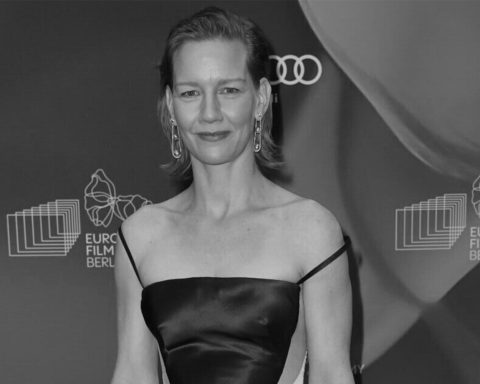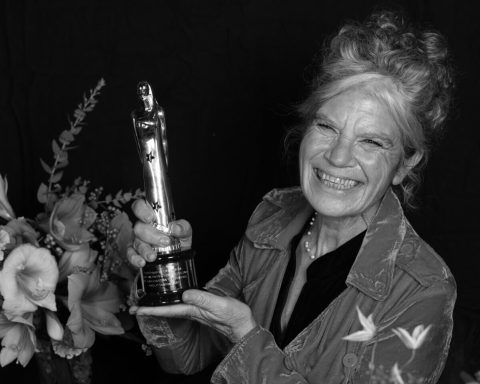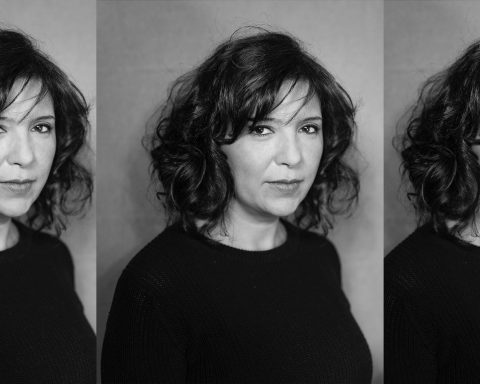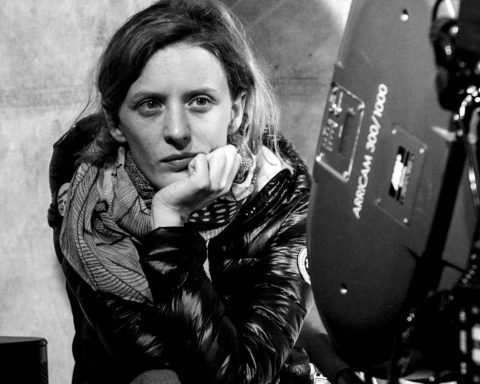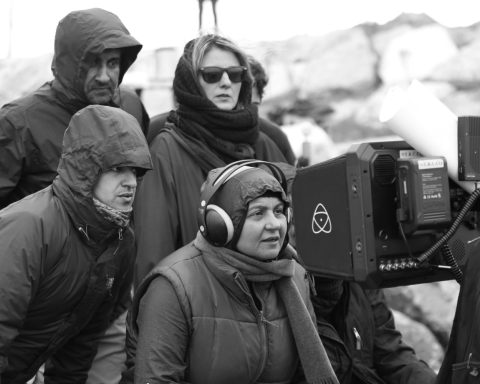Dalia Colli graduated in Decoration from the Academy of Fine Arts of Florence, after which she started working in a special makeup laboratory in Rome. She frequently works on Italian director Matteo Garrone’s films, a collaboration that has garnered her two Davide di Donatello Awards for “Reality” in 2013 and “Dogman” in 2019 (shared with special makeup designer Lorenzo Tamburini) as well as an EFA Award for “Dogman” in 2018, also shared with Tamburini. Dalia Colli has also worked on “Casanova” (2005), “Gomorrah” (2008), “Angels & Demons” (2009) and “Rainbow: A Private Affair” (2017) among many other films.
Tara Karajica caught up with her at this year’s Tallinn Black Nights Film Festival, where she gave a masterclass on how to create a character from the reading and interpretation of the script, the dialogue with the director and the other departments as well as all the possibilities of makeup within the framework of EFA masterclasses at Industry@Tallinn, a new Creative Gate training program intended for film professionals, art department students and those interested in costume design, production design, make-up, hair, visual effects and fashion.
Have you always known you wanted to be a makeup artist? How did you get into film?
Dalia Colli: No, in fact, I started in the set department. In 1999, I was in my first year of studies in Decoration at the Academy of Fine Arts in Florence and a little TV production came to my city, Leghorn, to shoot a short series. They asked me if I could take care of the locations and set decoration and I said: “Yes, of course!” I had never done it before, but I enjoyed myself a lot and everything went well. After this experience, I decided to move to Rome and study at the Academy of Fine Arts there. In 2001, I graduated and thanks to Paola Gattabrusi, a famous Italian makeup artist, I shot my first short film as a makeup artist.
You have worked with Matteo Garrone many times. Can you talk about this collaboration?
D.C.: I met Matteo Garrone in 2006 for the shoot of Gomorrah. He was maybe thirty-eight years old and his smile and eyes twinkled like a child in front of a pie. I was fascinated by his way of observing everything and seeing him enter his own dimension to make order in his mind. With him and thanks to him, I have always lived big experiences and emotions that I’ll remember forever.
What is the difference between working on U.S. and European productions?
D.C.: I worked with a U.S. production on two occasions. The first one was Casanova for Walt Disney and the second, Angels & Demons. Definitely, there was always a rich lunch on these productions! I think that if people working in the production department take care of me and respect my work and my human nature, I wake up happy going to work.
How is makeup perceived in the Italian film industry? How has it evolved since the glory days of Cinecittà?
D.C.: With the advent of technology that turned film into digital, make-up has radically changed. The techniques have changed. The products have changed. But what has also really changed is the money! Makeup reacts to light and because of it, if makeup and photography aren’t combined, you see that something is wrong. So, at first, you must speak with the director of photography to know what his intentions regarding the project are. A film is a sort of space-time portal through which you enter the dimension of the story, where nothing can stop the magic of the film, especially a bad prosthetic or, in simpler terms, a bad foundation! In Italy, makeup is perceived like an expensive, yet required department and I think that we have the art of embellishing and decorating in our DNA.
What triggers your creativity? What inspires you? How do you get in the zone and what is your work process like?
D.C.: I love to walk on the street and copy a look, a way of walking, or a haircut in my mind. I love to imagine what sort of work they do based on how they are dressed, based on their make-up, on their tattoos… Every one of these things is a message, an answer to the question: “Who are you?” And this is the question that I ask myself when I have to create a character. Often, I must look at very bloody or disgusting pictures in order to realize some special effect. The last ingredient is my creativity.
How does, in your opinion, makeup help complete the character and help the director tell his/her story?
D.C.: I’m sure makeup is an important help for the director and for the story. Think about films like Dogman, where the director Matteo Garrone needed an ex-boxer, but more than that, a good actor, for the character of Simoncino. Makeup helped Edoardo Pesce look like a man with a face of stone, with scars and a hand injury. Edoardo is a good actor, but thanks to the prosthetic creations of Lorenzo Tamburini, we believed he was indeed a retired bad boxer.
What are your biggest challenges when working on a film?
D.C.: When I work, I must fight against time and technical difficulties. Sometimes, we travel so much that we change our beds and pillows three times a week and our back is a piece of wood. But I’m sure that my biggest challenge is having to leave my daughter, my family and my home in order to go to work in another country or city. The passion for my job gives me this strength.
What is the role of CGI in terms of makeup? How does it help, but also hinder your work?
D.C.: I want say that fantasy films are my favorites. I love all the superhero films. I love space adventures and impossible missions because a child wakes up inside me every time. Despite this, CGI is a double-edged sword, especially for makeup and special makeup artists. At first, when we start creating the characters, we try to do drawings by hand, but mostly, we use them to create digital concepts. They are so realistic that when the director sees this, he/she pretends that this is that it will really be like! He/she doesn’t think about reality. He/she doesn’t think that maybe this sort of special makeup intervention is impossible to do because of the particular structure of an actor/actress’s face. So we have to be careful and use CGI when there’s no real possibility to realize what the director wants just with makeup. Now, everything seems to be a video game; one day, computers will direct digital actors in a digital film with, I hope, a human audience in the cinemas!
Can you talk about the use of prosthetics in the creation of a particular mask?
D.C.: Creating an aged special makeup, for example, is always a lengthy and difficult work. You start with the mold of a face, with a paste you distribute on all parts and after it has dried, you prepare the containment shell. An hour later, you have the positive copy of the actor’s face. Then, it is time to model the sulfur-free clay on the copy – you spend days to do this well – to reproduce the realistic texture of an old skin based on pictures of the parents of the actor/ actress in order to find the similarities between them because maybe the actor/actress ages the same way his parents do… You must know what thickness of clay is right, how to connect the different parts of the aged mask in order to cover the attachment of the prosthesis. When you are sure that the modeling is done, you must take the negative of the model: everything must be perfect because the slightest mistake could be your downfall. When the negative that usually is made in a sulfur-free resin is done, it is time to prepare the platinum silicon that will be pre-colored with silicon colors in order to find the right nuance of the actor/actress’s skin. After mixing the two silicon components, you pour the silicon into the negative part and close it with the positive part so that the silicon is catalyzed with a double side: the copy of the aged mask will be in the front and on the back, there will be the face imprint of the actor/actress. Usually, I separate prosthesis in seven parts: the forehead, the cheeks, the nose, the upper lip, the lower lip, the neck and the hands. It takes seven to ten days to make just one series of prosthesis so that they can be good and ready for a makeup test – with no possibility of error! It’s very hard work!
How careful do you have to be with an actor’s skin when applying makeup in terms of choice and quality of makeup? What is a no-go?
D.C.: Taking care of my actors/actresses is an important part of my job. I always ask them if they prefer some products more than others and I only use safe and clinically tested products, especially when I must use prosthetics and all the products to apply them. There are natural solvents like limonene, that is tolerated by the skin because it comes from lemon, but it’s as strong as lemon, so at the and of make-up removal, you must prepare hot wet towels in order to open the pores of the skin and the person is refreshed and clean. What we cannot do is continue to use some products when we see that they are too aggressive on the skin we are working on. If we notice a red or stressed zone, we must stop and change something.
What about the length of time an actor wears it during the shoot?
D.C.: When the story asks for prosthetic parts, the actor/actress who accepts the role must know that every day of his/her work, makeup will require three, four, five, six, seven hours… When I shot The Traitor, the protagonist, Pierfrancesco Favino, was in the make-up chair for six hours everyday and shot for another ten hours! Poor man!
How big is the actor’s input/say in the creation of his/her character in terms of makeup?
D.C.: When we decide the makeup together, the director and myself, we know who will play the character. When the casting works, the employees know what the director wants. So, at the moment of the makeup test, the actor/actress can suggest what he/she thinks about the character and, sometimes, he/she really helps us. Don’t forget that a film is the result of many, many combined minds!
What is a typical day on set for you like?
D.C.: When we shoot in the Base Camp, Rome City, every morning, someone takes me to the set with the other members of my department. As soon as possible, I drink a coffee to try and open my eyes. Makeup and hair are, with the production and set departments, the first ones to arrive on the set. Without us, the actors can’t be ready in time. So I start to prepare all the actors who work in the first scenes and, at the end, I leave for the set with them and take care of the scenes with my assistant. You can never forget that an unexpected occurrence is always around the corner! A perfect day on set is when it ends and everything has gone well. During the making of a film, there are different situations: one day, you can have to do simple things and the other five days you don’t have enough hands! I prefer when there are extras because I enjoyed myself with them a lot! I love bloody set days because you must dress with bad clothes and empty bottles of blood… As long as it’s fake, everyone has fun!
What is the best thing about your job? What do you love most about it and why?
D.C.: The best thing about my job is my job. I enjoy myself a lot because there is something new every single day. While I’m working, I must empty my mind, which is always full of chaos and concentrate myself totally on what I must do. If there is good music and a good conversation in the makeup trailer, the result will automatically be better! I also love to collaborate with all the crew in order to make a film where the atmosphere that surrounds us makes us happy when we need to wake up and go to work. I love to speak about ideas with the director. I don’t like when “time is money” because of which, quality is lost.
How close do you work with the costume department when creating (the makeup of) a character?
D.C.: The costume department is the basis of the characters. The appearance of the character depends on the costume. The makeup and hair departments must know how the character is dressed in order to create something relevant. During the creations of the characters, costume, hair and makeup gather together to speak about the ideas after which we do the tests with the director and the actors.
And with the light and camera?
D.C.: When you have read every Art History book, you know that the colors would not exists if it weren’t for light as color reacts to it so much. With the advent of HD support, this connection between the makeup, camera and photography departments is acknowledged and accepted.
Do you prefer contemporary makeup or period makeup?
D.C.: In my opinion, there’s no difference between a period makeup and a contemporary one. The most important thing is that it works and helps the story. In the historical films or westerns of the 1970s, you can often recognize the fashion and makeup that were in vogue at the time and used to characterize a woman who lived in 1880 in a desolate land in the American West, which is very funny now! So technique and sensibility must drive you.
How much is an education in Art History important for historical makeup?
D.C.: Certainly, my studies at the Academy of Fine Arts in Rome always helps me. I often take ideas from pictures or Art museums. Falling in love with Art when you are young sharpens your senses and your perception of Beauty and the balance of the image grows up with you. In order to do a historical makeup, you only must find pictures on the Internet and try to copy that.
Do you see big possibilities in the field of makeup in horror and sci-fi genres today?
D.C.: I love this genre and I see a lot of these films, but I must admit that, at the moment, I can’t remember one single title in the horror genre that I have seen recently that is not It or Stranger Things. If I think about Ridley Scott’s Alien, it seems impossible it was made in 1979. It never gets old! This film is based on anxiety; suspense is the real protagonist, the monster rarely appears and you use just a little bit of imagination until the very end when it shows itself in all it horrifying appearance… Just perfect! Maybe now, there are less good screenplays and we are addicted to the real violence around us, or maybe I’m getting old, but I need a beautiful horror story to see with my eyes half closed like when I was a child! I have worked on the set of two or three horror films, but they weren’t successful. I nevertheless enjoyed myself a lot!
How different is realistic makeup from just beautifying the actor and how much can makeup help actors with certain imperfections on their faces?
D.C.: The choice of makeup is always connected to the character that has to come alive. In every makeup that is not theater makeup, makeup must always be realistic. When I do special makeup, I must recreate reality. If, for instance, I’m doing a fairy of the forest and if the skin is blue, the blue must be credible. The same goes for a beauty makeup. If my actor or actress needs some makeup intervention to cover some imperfections or I have to illuminate their skin, I must do it in the most credible way. I always joke saying: “I’m a makeup artist, not a magician…” but we do often perform miracles!
Has it ever happened that the makeup was a crucial/surprising element in the interpretation of a certain role?
D.C.: Yes, of course. I hope that Garrone’s Pinocchio has this crucial/surprising element. In this film, makeup plays a very important role – both makeup and special makeup, because if they aren’t combined, one would cancel the success of the other. There are films with characters who are completely fake or made with makeup or with something changed because the character needs it, but the actor is the who needs it the most! The fantasy genre is based on that, actually.
How important are feature additions for the characterization of a character? Like adding a bigger nose on Nicole Kidman in The Hours, for example…
D.C.: The beautiful and masterful Nicole Kidman was supposed to look like Virginia Woolf, the writer of Mrs. Dalloway. Virginia wasn’t a beauty like Nicole and her face denotes an internal conflict. Because of that, the feature addition of a nose bigger then Nicole’s plays an important part in the creation of the character, in making us forget that she is not Nicole, but Virginia.
In that regard, how much can makeup actually hinder real acting on screen?
D.C.: To wear prosthetics, especially on the face, is not easy for a person in general, especially for an actor/actress who must move and speak in the most real way possible in order to look like the character. On the set of Bellocchio’s The Traitor, Pierfrancesco Favino played a famous head of Italian mafia, Tommaso Buscetta. Buscetta, in order to escape from the police, changed his face three times with the help of cosmetic surgery. Because of that, the actor had to have feature additions, but the director didn’t agree with that because he was scared of special makeup. The actor fought a lot in order to have the possibility to become this character with the help of special makeup. This choice turned out to be right in the end.
What is the formal education for makeup artists for film and what are the best schools?
D.C.: In Italy, the film industry was born in Rome; a big part of film history was born in Rome, this neorealistic city. Film industry jobs were passed on from father to son for generations. For whoever who wants to enter this interesting world, I would suggest they attend the Academy of Fine Arts or the Academy of Cinema and Costume to study Art History and Cinema in order to understand how the Seventh Art has changed and evolved. After creating a good cultural baggage, one must attend a good makeup course in Italy, England or America. In Italy, there are some good makeup schools, where the teachers are people who work on film sets. The school is a good starting point to get acquainted with the film environment and every experience is important for the training, but the best school is always the set, so good luck with that and always have a plan B in place!
What is the film you have worked on you are proudest of?
D.C.: The biggest challenge, absolutely, was when I shot Reality in 2011. My daughter was less than two months old and you can imagine what I was going through! Everything was new, even my job, which I had never done before. Matteo asked me if I was ready to start working and I said: “Yes, of course!” but I didn’t really know how I would do it. I bought a vintage van with all the comforts inside and left for Napoli, with my daughter and her nanny, on an adventure. The film was challenging and the locations were often very hardcore for a baby, but with my super 1970s van and the help of the people on the set, this particular story ended with my first David di Donatello Award!
There has been a lot of talk about the situation of women in the film industry in the past two years. What is your opinion? How is it in Italy and in makeup in particular?
D.C.: Scandals are the news that people prefer to read in the newspapers and watch on TV, even if these horrible facts have destroyed the lives of the victims when they are victims. The fact that in show business, sex and relationships, have always been a possible way in – especially for beautiful people – is not news. In my career, I have never been harassed. I believe that in the work environment of actress, this can can be a rare occurrence. There are bad people in the film industry as much as in all the other working environments. The real problem is that we live in a sexist and racist world where the majority of men see women with Neanderthal eyes and brain.
Who is your favorite female filmmaker and what female filmmaker would you like to work with?
D.C.: Martha Lauren, the executive director of the Center for the Study of Women in Television and Film of the University of San Diego, showed how the opportunities for a woman to work at the top in the film industry are less than before. Statistics say that just four percent of film productions are in the hands of a woman. Kathryn Bigelow is one of my favorite female directors. She made films like Point Break, a cult film of the 1990s, or Strange Days. She won an Oscar for Best Film for The Heart Locker in 2010 and after that, she made Zero Dark Thirty in 2012. She tackles male films with action, fights and special effects. If I were a director, I would like to be like her!
What are your next projects?
D.C.: My next project will be a WWII film, that we will shoot in Belgium and Italy. It will be a bloody adventure!
This interview was conducted at the 2019 Black Nights Film Festival.
Photo credit: Dalia Colli





